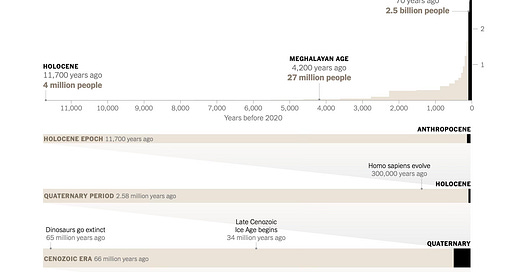The Anthropocene fails to summit the bureaucratic scientific ladder
The governing geological committee rejects the Human Epoch - for now
Scientists are, by their very nature, conservative in their judgments. They want overwhelming proof and clear boundaries established before they embrace a new definition as momentous as declaring the Holocene (begun at the end of the most recent Ice Age 12,000 years ago) having been superseded by the proposed Anthropocene (proposed to have begun mid-20th century, or thereabouts, given your scientific preference).
A quick primer:
The ‘Anthropocene’ is a term widely used since its coining by Paul Crutzen and Eugene Stoermer in 2000 to denote the present geological time interval, in which many conditions and processes on Earth are profoundly altered by human impact. This impact has intensified significantly since the onset of industrialization, taking us out of the Earth System state typical of the Holocene Epoch that post-dates the last glaciation.
The ‘Anthropocene’ has developed a range of meanings among vastly different scholarly communities …
Phenomena associated with the Anthropocene include: an order-of-magnitude increase in erosion and sediment transport associated with urbanization and agriculture; marked and abrupt anthropogenic perturbations of the cycles of elements such as carbon, nitrogen, phosphorus and various metals together with new chemical compounds; environmental changes generated by these perturbations, including global warming, sea-level rise, ocean acidification and spreading oceanic ‘dead zones’; rapid changes in the biosphere both on land and in the sea, as a result of habitat loss, predation, explosion of domestic animal populations and species invasions; and the proliferation and global dispersion of many new ‘minerals’ and ‘rocks’ including concrete, fly ash and plastics, and the myriad ‘technofossils’ produced from these and other materials.
Many of these changes will persist for millennia or longer, and are altering the trajectory of the Earth System, some with permanent effect. They are being reflected in a distinctive body of geological strata now accumulating, with potential to be preserved into the far future.
Well, despite that impressive list of measurable Earth-altering changes, just now the International Union of Geological Sciences (IUGS), the top-dog entity in deciding such things, rejected the adoption of the Anthropocene designation, in large part, it would seem, over the question of when it actually began (i.e., at what point in history do we declare the human influence to have tipped the geological scales?).
Keep reading with a 7-day free trial
Subscribe to Thomas P.M. Barnett’s Global Throughlines to keep reading this post and get 7 days of free access to the full post archives.




